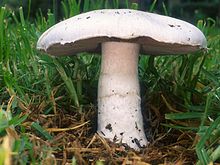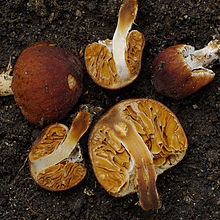Agaricales
| Agaricales | |
|---|---|

| |
| Agaricus campestris (field mushroom) (Agaricaceae) | |
| Scientific classification | |
| Domain: | Eukaryota |
| Kingdom: | Fungi |
| Division: | Basidiomycota |
| Class: | Agaricomycetes |
| Subclass: | Agaricomycetidae |
| Order: | Agaricales Underw. (1899)[2] |
| Subdivisions | |
| Synonyms[3] | |
|
Amanitales Jülich (1981) | |
The Agaricales are an
History, classification and phylogeny
| |||||||||||||||||||||||||||||||||||||||||||||||||||||||||||||||||||||||||||||||||||||||||||||||||||||||||||||||||||||||||||||||||||||||||||||||||||||||||
| Cladogram of the Agaricales, showing the division into six major clades, based on Matheny et al., 2006.[7] |
In his three volumes of
Molecular phylogenetics research has demonstrated that the euagarics clade is roughly equivalent to Singer's Agaricales sensu stricto.[11][12][13] A large-scale study by Brandon Matheny and colleagues used nucleic acid sequences representing six gene regions from 238 species in 146 genera to explore the phylogenetic grouping within the Agaricales. The analysis showed that most of the species tested could be grouped into six clades that were named the Agaricoid, Tricholomatoid, Marasmioid, Pluteoid, Hygrophoroid and Plicaturopsidoid clades.[7]

Molecular studies have shown that agarics are more divergent than once thought. Agarics in the genera
Distribution and habitat
Members of the Agaricales are ubiquitous, with species found in all continents. The great majority are terrestrial, in almost every habitat from woodland and grassland to deserts and dunes. Agaricoid species were long thought to be solely terrestrial, until the 2005 discovery of
the Agaricales include six
Genera Incertae sedis

There are several genera classified in the Agaricales that are i) poorly known, ii) have not been subjected to DNA analysis, or iii) if analysed phylogenetically do not group with as yet named or identified families, and have not been assigned to a specific family (i.e., Incertae sedis with respect to familial placement). These include:
- †Aureofungus Hibbett, Manfr. Binder & Zheng Wang (2003)
- Brunneocorticium Sheng H.Wu (2007)
- Cercopemyces T.J.Baroni, Kropp & V.S.Evenson (2014)
- Cheilophlebium Opiz & Gintl (1856)
- Cribrospora Pacioni & P.Fantini (2000)
- Hemipholiota (Singer) Bon (1986)
- Hemistropharia Jacobsson & E. Larss. (2007)[15]
- Infundibulicybe Harmaja (2003)
- Melanoleuca Pat. (1897)
- Mesophelliopsis Bat. & A.F.Vital (1957)
- †Palaeoagaracites Poinar & Buckley (2007)
- Panaeolina Maire (1933)
- Panaeolus (Fr.) Quél. (1872)
- R.Heim(1969)
- Plicatura Peck (1872)
- Sedecula Zeller (1941)
- Setchelliogaster Pouzar (1958)
- Trichocybe Vizzini (2010)
See also
References
- ^ PMID 28591180.
- ^ Underwood LM. (1899). Moulds, mildews and mushrooms: a guide to the systematic study of the Fungi and Mycetozoa and their literature. New York, New York: Henry Holt. p. 97.
- ^ "Agaricales Underw. 1899". MycoBank. International Mycological Association. Retrieved 2010-12-30.
- ^ "Catalogue of Life". Retrieved 2023-02-15.
- ^ PMID 17512712.
- ^ PMID 21148976.(subscription required)
- ^ PMID 17486974. Archived from the original(PDF) on 2016-03-03.
- ISBN 978-0-85199-826-8.
- ISBN 978-3-87429-254-2.
- ISBN 978-3-540-58008-9.
- PMID 9342352.
- PMID 12118409.
- PMID 12099793.
- S2CID 7175296.
- ^ Jacobsson S, Larsson E (2007). "Hemistropharia, a new genus in Agaricales". Mycotaxon. 102: 235–40.
External links
- Mushroom Expert The Gilled Mushrooms ("Agaricales")
- Tree of Life: Agaricales
